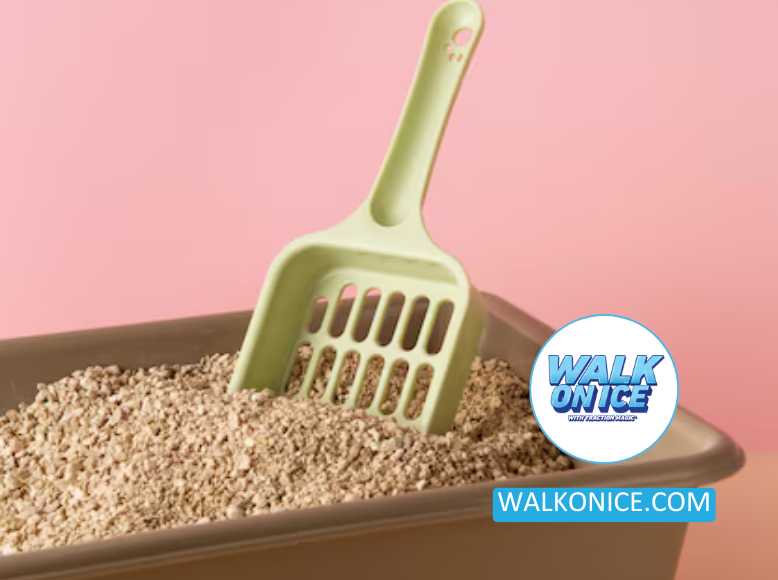Cat Litter To Melt Ice: Efficacy And Comparison With Traction Agents

Winter months bring the beauty of snow-covered landscapes, but they also bring the challenge of icy sidewalks, driveways, and roads. Many people turn to various methods to deal with this issue, and one of the more unconventional ones is using cat litter to melt ice. This article will discuss the efficacy of using cat litter to melt ice and compare it with traction agents like Walk On Ice.
Understanding The Cat Litter Ice Melt Method
Cat litter is commonly used as an absorbent material for cat waste, but some people also use it as a traction agent on icy surfaces. The idea is that the granular nature of cat litter can provide traction on slippery surfaces, making it easier to walk or drive. However, it’s essential to understand that cat litter does not actually melt ice. Instead, it provides a layer of material that can help increase traction and reduce slipperiness.
Different types of cat litter have different properties. Clumping cat litter, made from bentonite clay, is the most commonly used type. However, it can become mushy when wet and may not be the best option for icy surfaces. Non-clumping cat litter, made from materials like silica or recycled paper, may be a better option as it is less likely to become soggy.
Comparison With Traction Agents
Traction agents, like Walk On Ice, are specifically designed to provide traction on icy and slippery surfaces. Walk On Ice is made from a blend of natural volcanic rock and seven other minerals, making it non-corrosive, safe for pets, people, and your property. It can be used on sidewalks, steps, or as instant traction for your car.
When comparing cat litter to Walk On Ice, there are several key differences to consider:
- Effectiveness: Cat litter can provide some traction on icy surfaces, but it is not as effective as Walk On Ice. Walk On Ice is designed to provide instant traction on icy surfaces, making it a more reliable option.
- Messiness: Cat litter can become mushy and messy when wet, especially clumping cat litter. This can create a mess on the surfaces you are trying to make safer. On the other hand, Walk On Ice does not become mushy or create a mess, making it a cleaner option.
- Environmental Impact: Some cat litters may have a negative environmental impact, especially those made from non-biodegradable materials like silica. Walk On Ice on the other hand, is made from natural materials and is environmentally friendly.
- Cost: Cat litter may seem like a cost-effective option, but it may not be as economical in the long run because you may need to use more of it to achieve the same level of traction as a specialized product like Walk On Ice.
- Safety: Cat litter may contain additives or fragrances that could be harmful to pets or the environment. Walk On Ice is free from any harmful chemicals, making it safe for pets, people, and the environment.
Now, before we pack up the bag of cat litter for good, let’s address a few lingering questions people usually throw into the mix. After all, if we’re comparing cat litter with real traction agents like Walk On Ice, we may as well go all the way.
What Is Cat Litter Made Out Of, Really?
It might sound like a silly question—after all, cat litter is cat litter, right? But the truth is, it comes in a surprising variety of recipes. Traditional clumping litter is made from bentonite clay, which swells up like a sponge when it gets wet. Then you’ve got silica crystal litter, which looks almost like tiny grains of rock salt but is actually made from sand-based silica. Add to that paper pellets, wood shavings, and even corn-based litter, and suddenly the “cat litter” label covers quite a lot of ground.
The catch? None of these ingredients were designed with icy driveways in mind. Clay-based litter turns sludgy and freezes into hard clumps, silica can scatter but won’t stick, and recycled materials just get soggy. It’s a little like trying to use kitchen flour to fix a flat tire—it’s just not the right tool for the job.
Cat Litter for Traction: Helpful Hack or Winter Headache?
Yes, people do sprinkle cat litter for traction in the winter, and technically, it works… for about five minutes. Those gritty little pieces can give your boots or tires a momentary grip. But once moisture soaks in, clumping litters transform into a mushy mess, and non-clumping ones can scatter everywhere, leaving you with more cleanup than safety.
Think of it like putting cardboard under your car tires—it might get you unstuck once, but it’s hardly a dependable system. That’s where Walk On Ice takes the win. It doesn’t turn to mud, doesn’t leave behind dust, and doesn’t need to be shoveled up afterward. You sprinkle it, step on it, and get traction instantly. No drama, no winter headache.
Will Cat Litter Melt Snow and Ice? Spoiler: Nope
This is the part that trips people up. A lot of folks assume that if cat litter can handle pet mess, it might somehow melt ice too. But here’s the spoiler: cat litter will not melt snow and ice. It has zero melting properties. Unlike salts or chemical de-icers, it doesn’t lower the freezing point of water. It just sits there on top, and if it gets wet enough, it becomes part of the problem.
So while you may feel like you’re “treating” the ice by spreading litter, the ice underneath is still as slick as ever. The only thing you’ve added is a temporary grit. Walk On Ice takes a smarter approach—it doesn’t melt either, but it absorbs surface water and grips onto the ice like claws. The result is a stable, sandpaper-like surface that actually lets you move confidently, whether you’re walking, shoveling, or backing your car out of the driveway.
What Can Be Used as Cat Litter—and Would Any of It Work Outside?
This one comes up in both pet-owner groups and winter forums: “what can be used as cat litter?” Substitutes range from shredded newspaper and sawdust to rice husks and even sand. And yes, some of these can double up as traction materials in a pinch. Sand, for instance, is better than litter outdoors because it doesn’t turn to mush—but it still washes away quickly and can clog drains.
That’s the bigger point here: most household stand-ins aren’t designed to face winter ice. They’re makeshift solutions that create more problems over time. Specialized traction agents exist for a reason—they balance grip, cleanliness, and safety in ways that litter or sand can’t. Walk On Ice was built for this exact challenge. It works instantly, stays put, and won’t harm your driveway, pets, or the environment.
Get ready for winter with Walk On Ice instant traction on snow and ice
Conclusion
So, can you toss cat litter on your icy driveway? Sure. But should you? Probably not. It’s a quirky winter hack at best and a frustrating mess at worst. Cat litter wasn’t made for icy sidewalks—it was made for litter boxes. And while it can provide a momentary fix, it comes with slush, mud, dust, and disappointment attached.
If safety, reliability, and peace of mind are the goal, the smarter choice is a product made to handle ice directly. Walk On Ice isn’t a hack—it’s a solution. It keeps your footing secure, your home cleaner, and your winter routine a lot less stressful. Because when the world outside turns slick and unpredictable, the last thing you need is a product that wasn’t designed for the job in the first place.
Other Ice Melt Products
Safe Paw
The Original and #1 Selling Pet and Child Safe Ice Melt for over 20 years. Guaranteed environmentally safe – will not harm waterways and sensitive wetlands. All products are made in the USA.

Safe Thaw
Imagine an ice melt you can put down and never worry about. It won’t harm pets, kids, and your property. That’s Safe Thaw. Unlike anything else on the market, Safe Thaw can change how winter affects our planet.



